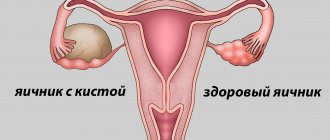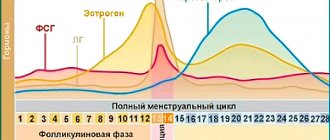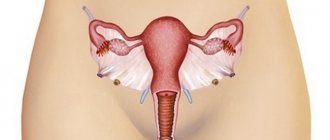IT IS IMPORTANT TO KNOW! An effective remedy for CYSTS without surgery and hormones, recommended by Irina Yakovleva! Read more…
An ovarian cyst is one of the most dangerous, and, unfortunately, the most common gynecological diseases, occurring mainly in women of reproductive age. This is a benign formation located on the tissues of the ovary and has the shape of a bubble filled with liquid, sometimes with bloody impurities.
The main danger of ovarian cysts is that this disease can lead to serious problems with conception, and subsequently to infertility. In addition, the so-called “leg” of the cyst can twist, which can lead to severe internal bleeding. Well, perhaps the main danger of this gynecological pathology is that it can change from a benign form to a malignant one. These and many other factors clearly indicate that the treatment of ovarian cysts should be approached with all responsibility and seriousness. Utrozhestan is one of the effective medications used to treat ovarian cysts. What is Utrozhestan and how to use this medicine in the treatment of gynecological diseases?
pharmachologic effect
The use of Utrozhestan compensates for the lack of progesterone. The plant origin of the drug allows the molecules of this hormone to be repeated as accurately as possible, as a result of which the drug is completely absorbed.
The effect of the drug on the body with an ovarian cyst:
- increased progesterone levels;
- normalization of the course of the second phase of the cycle;
- stimulation of the onset of menstruation;
- decreased levels of estrogens and androgens;
- increased chance of pregnancy;
- restoration of ovarian function;
- preparation of the endometrium of the uterus for the implantation of the fertilized egg;
- reduction in the size of cysts and their complete elimination;
- sedative effect;
- decreased uterine tone.
Utrozhestan is usually prescribed for follicular and other functional ovarian cysts caused by menstrual irregularities.
The medicine is available in the form of capsules for oral use or vaginal administration with a gelatin shell, having a light yellowish tint. There are suppositories on sale with dosages of 100 and 200 mg of progesterone.
Diagnosis of endometrioid cyst
The primary symptoms of endometrioid ovarian cysts are very similar to the symptoms of other types of cysts. To accurately diagnose the disease, a number of laboratory and instrumental studies are prescribed.
The “chocolate cyst” is clearly visualized during ultrasound examination; it is clearly visible as a white spot on a black background. But for an accurate diagnosis, a single ultrasound is not enough, since the endometrioid cyst is similar to the corpus luteum cyst (functional) and dermoid cyst. Therefore, you should watch the cyst over time - the functional cyst will resolve on its own, but the endometriotic cyst will remain unchanged or increase in size. The patient may also be prescribed a computed tomography scan, laparoscopy, and puncture of the cyst contents.
As part of laboratory diagnostics, the following studies are carried out:
- clinical blood test;
- blood test for hormones;
- study of tumor markers (often with endometriosis, the level of CA-125 increases).
How to take Utrozhestan for ovarian cysts
The dosage is determined individually by the attending physician. To prescribe a regimen for taking Utrozhestan for functional ovarian cysts, information about the state of hormonal levels, the characteristics of the patient’s body and her age is necessary.
When prescribing 200 mg of progesterone per day, it is possible to take one capsule with the appropriate dosage or two capsules per day of 100 mg each, 12 hours apart. If you need to take 400 mg of Utrozhestan, you should use one 200 mg capsule twice a day.
After vaginal administration of the drug, you need to lie down for about half an hour to prevent the drug from leaking out and to better absorb it.
Utrozhestan suppositories should be used for cysts of the left or right ovary from the 16th to the 25th day of the cycle inclusive. For amenorrhea, the start date of treatment is determined by the doctor, but in most cases you can take the first capsule on any convenient day.
The course of treatment for ovarian cysts is 3-6 months. It can be changed in accordance with the nature of the pathology and in the absence of a positive result from use.
According to women's reviews, Utrozhestan quickly eliminates functional type ovarian cysts and does not require an additional course of therapy.
Types of endometrioid cyst
Depending on their location, endometrioid cysts can be of two types: unilateral and bilateral. Unilateral endometrioid cysts are extremely rare. Most often, this pathology affects two ovaries at once.
According to the distribution of the lesion in gynecology, there are 4 degrees of “chocolate cyst”
- The 1st degree is expressed by small pinpoint formations on the surface of the ovaries, which are difficult to detect even with ultrasound diagnostics.
- The 2nd degree is the direct formation of the cyst itself, measuring about 5 cm. Small adhesions may be observed in the abdominal area.
- The 3rd degree is manifested by a cyst size of 6 or more centimeters, adhesions increase in size, endometriosis affects the uterine cavity and female genital organs.
- The 4th degree is considered the most severe. Cysts fill both ovaries and grow to a size of 10-12 cm. And endometriosis spreads to many nearby organs - the urinary tract, intestines, abdominal and uterine cavity.
Side effects and overdose
The development of side effects is likely if the Utrozhestan treatment regimen is not followed, capsules are missed, contraindications are ignored, or the individual characteristics of the body are ignored. Signs of side effects of the drug:
- headache, dizziness;
- mood swings;
- allergic reactions on the skin;
- spotting bloody discharge from the vagina.
Overdose is possible only when taking capsules orally. Symptoms are side effects. If these signs appear, you should immediately consult a doctor.
Features of application
Before starting treatment for endometrioid and other ovarian cysts with Utrozhestan, it is necessary to take into account all the features of its use. Additional characteristics of the drug:
- allowed during pregnancy, but only with the prescription of a gynecologist;
- has little effect on concentration and ability to drive;
- does not have a contraceptive effect;
- does not cause weight gain;
- treatment with Utrozhestan is often accompanied by drowsiness.
When administered orally, the drug enhances the effect of diuretics, immunosuppressants, anticoagulants, and medications to lower blood pressure. The effect of Utrozhestan decreases when taking antibiotics, alcohol, or smoking.
Which is better - Utrozhestan or Duphaston for ovarian cysts
Duphaston is a progesterone-containing drug produced in tablet form. Has the following characteristics:
- synthetic analogue of progesterone;
- no side effects from the action of the hormone;
- Only oral administration is allowed;
- contains 10 mg of the active substance - dydrogesterone, which is equivalent to one capsule of Utrozhestan 100 mg;
- allowed during pregnancy.
During gestation, taking Duphaston is recommended no more than up to 16-20 weeks, after which it is replaced by vaginal use of Utrozhestan.
The type of drug for the treatment of ovarian cysts is determined by the doctor. The main advantage of Duphaston is the absence of side effects, Utrozhestan is the possibility of vaginal use, which eliminates the burden on the gastrointestinal tract.
Reception for other diseases
Utrozhestan is used for various diseases accompanied by hormonal imbalance, in particular low levels of progesterone. Pathologies and dosage regimen:
| Indication | Reception scheme |
| Insufficiency of the second phase of the cycle, menopause | Orally, 1 capsule 100 mg 2-3 times a day, on days 16-25 of the cycle. |
| Low progesterone levels | Orally, 2 capsules of 100 mg on days 16-25 of the cycle, in menopause - 25 days. |
| Progesterone deficiency during pregnancy | Vaginally, 200-400 mg per day until week 20, 100 mg per day until week 32. |
| In Vitro Fertilization | Vaginally, 400-600 mg per day from the first day of the procedure until the 20th week of pregnancy. |
| Prevention of spontaneous abortion | Vaginally, 200-400 mg per day until the 20th week of pregnancy. |
| Infertility | Vaginally, 200-300 mg per day from days 16 to 25 of the cycle. |
Before use, you should consult your doctor. Self-treatment with Utrozhestan is prohibited.
During pregnancy
During pregnancy, a lack of progesterone can lead to miscarriage. Low levels of this hormone increase uterine contractility. In this case, drug support with Utrozhestan is required. Effect of the drug during gestation against the background of an ovarian cyst:
- prevention of tumor growth;
- maintaining the vital activity of the fetus;
- normalization of progesterone levels in the blood;
- preventing spontaneous abortion.
During pregnancy with an ovarian cyst, Utrozhestan is necessary only with a low level of progesterone. Its use is also possible in case of active growth of an ovarian cyst against the background of hormonal imbalance. In other cases, the use of the medication is not advisable.
Treatment during thrush
The action of Utrozhestan does not affect the occurrence of thrush in any way. The main reason for the exacerbation of candidiasis during the treatment of ovarian cysts is insufficient hygiene of the genital organs in the case of vaginal use of capsules. This is due to the large amount of discharge due to suppositories and the need to wear daily sanitary pads, which promotes the development of yeast-like bacteria. Therefore, when treating with Utrozhestan, it is recommended to wash the genitals with clean water 2-3 times a day.
The effect of the medication on ovulation
Progesterone is the hormone of the second phase of the menstrual cycle. For ovulation to occur, a high level of estrogen is required, as well as a sharp release of luteinizing hormone. The latter is produced by the pituitary gland, its concentration increases sharply immediately before the release of the egg.
A large amount of progesterone slightly reduces the production of LH. This can delay ovulation several days later. This effect from taking Utrozhestan does not harm the body and does not reduce the likelihood of pregnancy.
Treatment of ovarian cysts with Utrozhestan is necessary for low progesterone levels and absence of menstruation. The drug helps restore the cycle and eliminate the tumor. To reduce the intensity of side effects, it is recommended to use capsules for vaginal administration.
Contraindications for use
Utrozhestan should not be used in the following cases:
- the presence of thrombophlebitis, acute phlebitis, varicose veins;
- incomplete abortion;
- bleeding from the genitals, the cause of which has not been established;
- porphyria;
- the presence of malignant neoplasms in the genitals or mammary glands;
- hypersensitivity to one or more components of the drug;
- the presence of serious liver or kidney dysfunction.
For diabetes mellitus, bronchial asthma, various cardiovascular diseases, arterial hypertension, epilepsy, severe and prolonged depressive states, Utrozhestan is allowed to be taken, but only under constant medical supervision.











